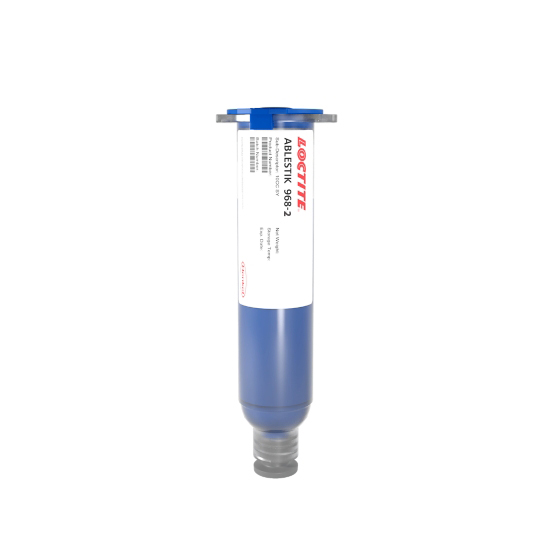LOCTITE ABLESTIK 968-2
- Electrically insulating
- Hybrid chemistry
- Dispense and Stencil print
Product Description
LOCTITE ABLESTIK 968-2 die attach adhesive is designed for microelectronic chip bonding applications. This adhesive is ideal for application by syringe dispensing or screen printing. It has been used for large die sensor die attach.
LOCTITE ABLESTIK 968-2 is an electrically insulating epoxy with a proprietary hybrid chemistry. It is successfully used in aerospace and defense applications, meets the requirements of MIL-STD-883, Method 5011 and can pass the NASA outgassing standard if properly cured.
Cure Schedule
- 2 hours @ 150°C
Technical Specifications
| General Properties | |
| Work life @25°C Work life @25°C Work life is the amount of time we have to work with a material until it is no longer able to be easily worked and applied on a substrate. It is based on the change in viscosity and it can rely on the application requirements. | 96 hours |
| Thermal Properties | |
| Glass Transition Temperature (Tg) Glass Transition Temperature (Tg) The glass transition temperature for organic adhesives is a temperature region where the polymers change from glassy and brittle to soft and rubbery. Increasing the temperature further continues the softening process as the viscosity drops too. Temperatures between the glass transition temperature and below the decomposition point of the adhesive are the best region for bonding. The glass-transition temperature Tg of a material characterizes the range of temperatures over which this glass transition occurs. | 139 °C |
| Thermal Conductivity Thermal Conductivity Thermal conductivity describes the ability of a material to conduct heat. It is required by power packages in order to dissipate heat and maintain stable electrical performance. Thermal conductivity units are [W/(m K)] in the SI system and [Btu/(hr ft °F)] in the Imperial system. | 0.865 W/m.K |
| Physical Properties | |
| Viscosity Viscosity Viscosity is a measurement of a fluid’s resistance to flow. Viscosity is commonly measured in centiPoise (cP). One cP is defined as the viscosity of water and all other viscosities are derived from this base. MPa is another common unit with a 1:1 conversion to cP. A product like honey would have a much higher viscosity -around 10,000 cPs- compared to water. As a result, honey would flow much slower out of a tipped glass than water would. The viscosity of a material can be decreased with an increase in temperature in order to better suit an application | 45,000 mPa.s |
Additional Information
The trace below indicates a calculated “onset” of cure at about 158°C. But the cure starts below that – typically 30°C for this type of chemistry – and we know from long experience with 968-2 that the cure starts happily at 125°C.

968-2 Temperature Scan
Are you having issues with leakage?
Even this is not to be expected, air pressure within the package could lead to some leakage in certain configurations. In this case there are some solutions that you can consider.
- Vent hole: The “optimum” solution is to introduce a vent-hole. Either a small hole in the package, or an incomplete dispensed ring of 968-2. Then “plug” the hole after the 968-2 is cured. This can be done with a small amount of low temperature cure epoxy, or a UV/thermal dual-cure adhesive (eg NCA2280). Yes – the “plug” represents a potential weak point in the structure. However, it is a very small volume of material. If a filled adhesive is used, the CTE could be similar to the 968-2 and the very small volume will give low outgassing. Products like Eccobond 45 & Eccobond 104 & Stycast 2850FT might be worth a try.
- Optimize curing: It might be possible to optimise the 968-2 sealing with a slower of faster temperature ramp during cure. This would need to be determined experimentally. A very slow ramp rate from 25°C to the cure temperature might allow the air to diffuse through the glue, without moving the glue.
- Higher viscosity pastes: Products such as 968-4 with higher viscosity can help withstand the air pressure better and prevent any leakage.



